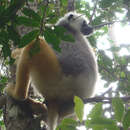Biology
provided by Arkive
Sifakas are diurnal and spend almost all of their time in the trees (2). The majority of behavioural studies of this species have been carried out on Milne-Edward's sifaka and these are thought to be broadly similar for the 3 other subspecies (2). These sifakas occur in multi-male, multi-female groups of between 3 and 8 individuals (4), who occupy large, exclusive territories that are depicted by scent-markings at the boundaries. Births for Milne-Edward's sifaka occur in May and July although those for other subspecies may take place later in the year (4). A female will give birth to a single offspring every couple of years; the infant initially clings to its mothers belly before transferring to her back after a month (4). Sexual maturity is reached at 4 to 5 years of age and, whilst males disperse, females remain within their natal group and are the dominant sex in the group (4).
Sifakas move through the trees by vertical clinging and leaping (2). Feeding takes place at all levels of the canopy, predominately on leaves, although fruit, young shoots and flowers may also be eaten in season (2). Individuals may alight on the ground to search for fallen fruit and to engage in play-fighting, some sifakas have also been seen to eat soil, possibly in an effort to rid themselves of toxins (4).
Conservation
provided by Arkive
All of the diademed sifaka subspecies occur in a least one protected range; P. d. diadema has been confirmed from at least 5, whilst Perrier's sifaka is thought to be found only within the Analamera Special Reserve (4). Further research and protection is needed if these appealing and interesting primates are to be saved from extinction.
Description
provided by Arkive
The diademed sifaka is one of the largest lemurs, with a lustrous, silky coat. These lemurs have long powerful legs and grasping hands and feet, which allow them to leap from one vertical trunk to another in their arboreal habitat. The species is currently thought to be composed of 4 distinct subspecies, each of which is very different in appearance (4). The diademed sifaka (Propithecus diadema diadema) from which the species name is derived is one of the most attractive and largest of the sifakas. The coat is white on the head with a dark crown; the rest of the body varies in shades of grey except for the rich golden-orange of the arms and legs, and the hands, feet and face, which are black (4). Perrier's sifaka (P. d. perrieri) in contrast, is the smallest of the 4 subspecies and the dense coat is completely black (4). Milne-Edward's sifaka (P. d. edwardsi) has soft chocolate-brown fur with a creamy-white saddle on the lower back, and piercing orange-red eyes, which stand out against the dark face (4). The long, sleek, creamy-white coat of the silky sifaka (P. d. candidus) is also striking; the face is usually black and the eyes orange-red, although some individuals lack dark pigment giving their skin a pink tinge (4).
Habitat
provided by Arkive
Predominantly inhabits primary and montane rainforest, although Perrier's sifaka is also found in dry-deciduous forest (4).
Range
provided by Arkive
The diademed sifaka is found in eastern Madagascar, in a range that extends from the Mananara River in the south to the northern tip of the island (3). Within this area the 4 subspecies appear to occupy non-overlapping ranges with Milne-Edwards sifaka in the south and Perrier's sifaka in the north; occupying the most restricted area (4). P. d. diadema has the largest range of the four, situated between Milne-Edward's sifaka and the silky sifaka (4).
Status
provided by Arkive
Classified as Critically Endangered (CR - A2cd, B1+2c) on the IUCN Red List 2002 (1), and listed on Appendix I of CITES (6).
Subspecies: Diademed sifaka (Propithecus diadema diadema) classified as Critically Endangered (CR - A1cd); Milne-Edwards's sifaka (P. d. edwardsi) classified as Endangered (EN - A1c); silky sifaka (P. d. candidus) classified as Critically Endangered (CR - A2cd, B1+2bc); Perrier's sifaka (P. d. perrieri) classified as Critically Endangered (CR - A2cd, B1+2c) (1).
Threats
provided by Arkive
Habitat destruction is the major cause of the decline of the diademed sifaka. Primary forests are being cleared to make way for agriculture, for the extraction of timber and for charcoal production (4). Some subspecies may also be hunted for food in parts of their range and deliberate fires further encroach on what is an already highly- fragmented habitat (4). Perrier's sifaka is the most endangered of the diademed sifakas, and possibly the most endangered of all the lemurs; estimates in 1998 put the population at around 2,000 individuals with none in captivity (5).

